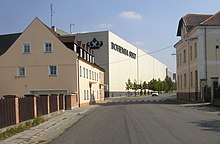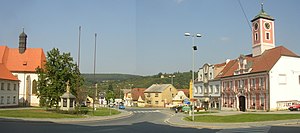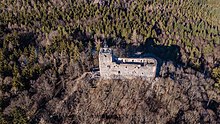Starý Plzenec
Starý Plzenec | |
|---|---|
 Starý Plzenec as seen from the Radyně Hill | |
| Coordinates: 49°41′52″N 13°28′25″E / 49.69778°N 13.47361°E | |
| Country | |
| Region | Plzeň |
| District | Plzeň-City |
| First mentioned | 976 |
| Government | |
| • Mayor | Jan Eret |
| Area | |
| • Total | 18.37 km2 (7.09 sq mi) |
| Elevation | 343 m (1,125 ft) |
| Population (2024-01-01)[1] | |
| • Total | 5,448 |
| • Density | 300/km2 (770/sq mi) |
| Time zone | UTC+1 (CET) |
| • Summer (DST) | UTC+2 (CEST) |
| Postal code | 332 02 |
| Website | www |
Starý Plzenec (Czech pronunciation: [ˈstariː ˈpl̩zɛnɛts]; German: Altpilsen) is a town in Plzeň-City District in the Plzeň Region of the Czech Republic. It has about 5,400 inhabitants.
Administrative parts
[edit]The village of Sedlec is an administrative part of Starý Plzenec.
Geography
[edit]Starý Plzenec is located about 5 kilometres (3 mi) southeast of Plzeň. It lies in the Švihov Highlands. The highest point is the Radyně Hill at 567 m (1,860 ft) above sea level. The Úslava River flows through the town.
History
[edit]The first written mention of the settlement is from a chronicle of Thietmar of Merseburg and dates to 976, when Duke Boleslaus II defeated a Bavarian army below a local stronghold, then called Plzeň.[2] The urban settlement below the castle evolved into an administrative and mercantile centre of western Bohemia, but this came to an end in 1295, when King Wenceslaus II founded the new city of Plzeň in a more suitable location at the nearby confluence of the Mže and Radbuza rivers. The new city soon took over the functions of old Plzeň and became known as Nová Plzeň ("New Plzeň"), later simply as Plzeň, while the older settlement was called Stará Plzeň ("Old Plzeň"). From 1442 at the latest, the old town was called Starý Plzenec.[3]
Demographics
[edit]
|
|
| ||||||||||||||||||||||||||||||||||||||||||||||||||||||
| Source: Censuses[4][5] | ||||||||||||||||||||||||||||||||||||||||||||||||||||||||
Economy
[edit]
Starý Plzenec is known for the sparkling wine producer, Bohemia Sekt company. It is the biggest sparking wine producer in the Czech Republic and one of the biggest in Central and Eastern Europe.[6] The production started here in 1943 in the premises of the former brewery, which was active in 1873–1929.[7]
Transport
[edit]The D5 motorway, which connects Prague with Plzeň, passes through the municipal territory.
Starý Plzenec is located on the railway line Plzeň–Nepomuk.
Sights
[edit]
Radyně Castle is a ruin of a medieval castle from the 14th century open to the public, located on the Radyně Hill above the town (to the south).
On Hůrka Hill above the town there are the Rotunda of Saints Peter and Paul, a Romanesque church from the late 10th century, and the foundations of other buildings of the old gord.[8] Since 1978, the area has been protected as a national cultural monument.[9]
Notable people
[edit]- Filip Jícha (born 1982), handballer
References
[edit]- ^ "Population of Municipalities – 1 January 2024". Czech Statistical Office. 2024-05-17.
- ^ "Počátky" (in Czech). Město Starý Plzenec. Retrieved 2021-06-08.
- ^ "Historické město" (in Czech). Město Starý Plzenec. Retrieved 2024-05-31.
- ^ "Historický lexikon obcí České republiky 1869–2011" (in Czech). Czech Statistical Office. 2015-12-21.
- ^ "Population Census 2021: Population by sex". Public Database. Czech Statistical Office. 2021-03-27.
- ^ "Company profile". Bohemia Sekt, s.r.o. Retrieved 2021-06-08.
- ^ "The history of Bohemia Sekt". Bohemia Sekt, s.r.o. Retrieved 2021-06-08.
- ^ "Historie rotundy sv. Petra a Pavla" (in Czech). Rotunda Hůrka. Retrieved 2023-02-20.
- ^ "Hradiště Hůrka" (in Czech). National Heritage Institute. Retrieved 2023-02-20.




